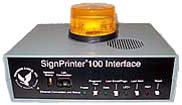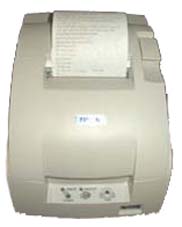AE120 EAS and SAME Decoder
Thunder Eagle® added the WeatherEagle®110 (WE110) receiver with the AlertEagle®120 (AE120) SAME/EAS (Specific Area Message Encoded/Emergency Alert System) decoder to create a reliable and flexible system that captures weather alerts, filtered by event and location, and places the 'matched' event and location alerts on communications systems.
The AE120 is engineered for durability with modern surface-mount technology. The unit has special audio filters and amplifiers to provide the most reliable SAME/EAS decoding capabilities. The WE110/AE120 is especially useful for EOC's (Emergency Operations Centers) and PSAP's (Public Safety Answering Points), factory and school public address systems, two way radio systems, highway advisory radio systems, security offices, mobile communications vehicles and command posts
How to Select Alerts for Specific Events and Locations
Using Thunder Eagle's easy to use FipsFileMaker™ software, users can create a text file of selected events and locations that the AE120 will "match" against the incoming SAME/EAS alert messages. This file is uploaded into the AE120 by using Thunder Eagle's FipsLoader™ software.
When an event and location match is detected, the WE110 unmutes, the AE120 closes a double pole, double throw relay, and the unit is placed into alert mode for a user/software settable period of time between 1 second and
either 2 minutes or the End of Message signal, which ever occurs first. The default alert period is 1 minute and 30 seconds. At the end of the alert period, the WE110 will mute and the relay will open.
If the NWS End of Message signal is detected, the AE120 will signal the WE110 to immediately mute.
Diagnostic Features
As a result of years of research and development, the AE120 has many patented diagnostic features that provide positive feedback about the operation of the entire EAS/SAME system. These features include:
- A real-time FSK Lock-Detect LED. This patented diagnostic feature instantly informs the user when there is audio on the NWS (National Weather Service) NOAA Weather Radio (NWR) channel, no audio on the channel, and when the NWS is transmitting and EAS/SAME message.
- The WE110 digitally records the most recent audio alert, based on the 1050 Hz wide area alert tone, for later playback, similar to an answering machine. The recorded audio can be compared to determine whether the AE120 properly matched the alert message.
- LEDs on the AE120 automatically inform the user of each step in the EAS/SAME alerting process, including the real time occurrence of each FSK SAME/EAS burst, whether or not the event and location matched, and whether the End of Message (EOM) signal was decoded.
- All of the details of the last alert are saved in non volatile (will not be erased if the power is interrupted) memory including the actual decoded EAS/SAME bursts (there are 3), the match location, the match event, whether or not a match was found and whether or not the EOM signal was decoded. This data is also automatically output in ascii text format as part of each alert message cycle. Many clients capture this information into an external log file for later, and often remote, analysis and verification.
- A “Last Alert” button sends the most recent alert received out to the RS-232 printer port for diagnostic purposes.
- Holding in the Last Alert button on power up outputs the event and location match file for verification of setup.
- A “Reset” button mutes the WE110 speaker and opens the alert relay to manually reset the system.
- A "Test" button runs the WE110/AE120 though an alert cycle to aid in installation and troubleshooting.
- An "Audio-In" connector on the AE120 enables the system to be tested with recorded .wav audio files of actual EAS/SAME tests. These audio files are available for download from this web site.
|

WE110 – Stand-alone Receiver

WE110R-Rack Mount

WE110 Receiver -
AE120 SAME-EAS Decoder

WE105 Receiver -
AE400 SAME-EAS
Decoder
Translates Alerts to Text

MRI-100 MultiRadio Interface

FipsServer Custom Weather Website

SP100 SignPrinter Interface

One Line LED Signboard

Two Line LED Signboard

Rugged Printer

Strobe Light
|



